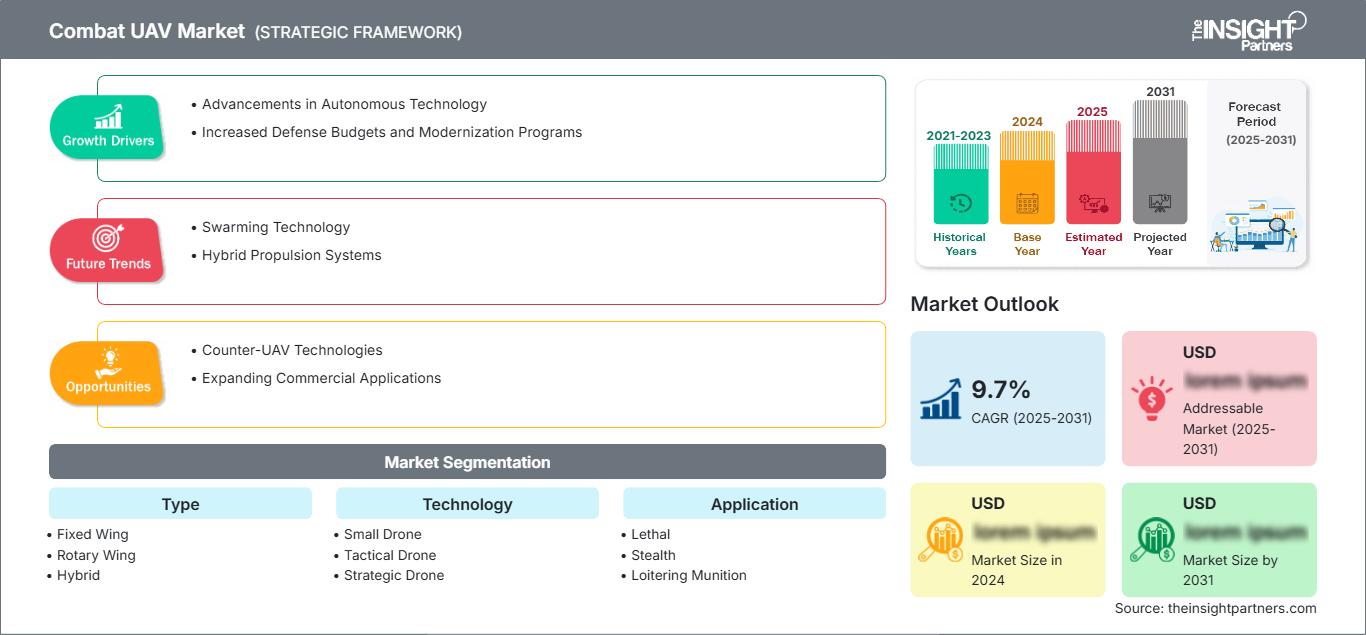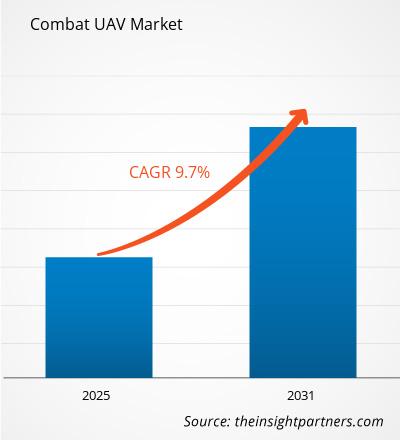Se espera que el mercado de vehículos aéreos no tripulados de combate registre una CAGR del 9,7 % entre 2025 y 2031, y que el tamaño del mercado se expanda de XX millones de dólares estadounidenses en 2024 a XX millones de dólares estadounidenses en 2031.
El informe está segmentado por tipo de dron (ala fija, ala rotatoria, híbrido); tecnología (dron pequeño, dron táctico, dron estratégico); aplicación (letal, sigiloso, munición merodeadora, objetivo); modo de lanzamiento (lanzamiento aéreo, despegue y aterrizaje vertical, lanzamiento por catapulta, lanzamiento manual, despegue y aterrizaje automático). El análisis global se desglosa a nivel regional y por países principales. El informe ofrece el valor en USD para el análisis y los segmentos mencionados.
Propósito del Informe
El informe "Mercado de UAV de Combate" de The Insight Partners busca describir el panorama actual y el crecimiento futuro, los principales factores impulsores, los desafíos y las oportunidades. Esto proporcionará información a diversas partes interesadas del negocio, como:
- Proveedores/fabricantes de tecnología: Para comprender la dinámica cambiante del mercado y conocer las oportunidades potenciales de crecimiento, lo que les permitirá tomar decisiones estratégicas informadas.
- Inversores: Realizar un análisis exhaustivo de tendencias respecto a la tasa de crecimiento del mercado, las proyecciones financieras del mercado y las oportunidades que existen en toda la cadena de valor.
- Órganos reguladores: Regular las políticas y las actividades policiales en el mercado con el objetivo de minimizar el abuso, preservar la confianza de los inversores y defender la integridad y estabilidad del mercado.
Segmentación del mercado de vehículos aéreos no tripulados de combate
Tipo
- Ala fija
- Ala rotatoria
- Híbrido
Tecnología
- Dron pequeño
- Dron táctico
- Dron estratégico
Solicitud
- Letal
- Sigilo
- Munición merodeadora
- Objetivo
Modo de lanzamiento
- Lanzado desde el aire
- Despegue y aterrizaje verticales
- Catapulta lanzada
- Lanzado a mano
- Despegue y aterrizaje automáticos
Recibirá personalización de cualquier informe, sin cargo, incluidas partes de este informe o análisis a nivel de país, paquete de datos de Excel, y además aprovechará grandes ofertas y descuentos para empresas emergentes y universidades.
Mercado de vehículos aéreos no tripulados de combate: perspectivas estratégicas

- Obtenga las principales tendencias clave del mercado de este informe.Esta muestra GRATUITA incluirá análisis de datos, desde tendencias del mercado hasta estimaciones y pronósticos.
Factores que impulsan el crecimiento del mercado de vehículos aéreos no tripulados de combate
- Avances en tecnología autónoma: El rápido desarrollo de la IA y las tecnologías de aprendizaje automático ha revolucionado las capacidades de los UAV. Los sistemas autónomos permiten a los UAV de combate realizar misiones complejas con mínima intervención humana, mejorando la eficiencia operativa y reduciendo el riesgo para el personal humano. Estos avances están haciendo que los UAV sean más fiables para la vigilancia, el reconocimiento e incluso las operaciones de combate, lo que impulsa a las fuerzas militares de todo el mundo a integrar estos sistemas en sus arsenales.
- Aumento de los presupuestos de defensa y programas de modernización: Los países están incrementando significativamente el gasto en defensa, especialmente en respuesta a las tensiones geopolíticas. Esto incluye inversiones sustanciales en sistemas no tripulados, como los UAV de combate, por su capacidad para ejecutar ataques de precisión y recopilar inteligencia en tiempo real. Los programas de modernización enfatizan la necesidad de plataformas aéreas no tripuladas avanzadas, lo que impulsa la demanda de UAV de combate en múltiples sectores militares.
Tendencias futuras del mercado de vehículos aéreos no tripulados de combate
- Tecnología de enjambre: El enjambre, que implica el despliegue de múltiples UAV que operan en tándem, está ganando terreno en escenarios de combate. Estos enjambres pueden superar las defensas enemigas, realizar reconocimientos y ejecutar ataques sincronizados. Las mejoras en las comunicaciones, la IA y el software de coordinación son factores clave en la creciente adopción de esta tendencia, ya que los ejércitos exploran maneras de desplegar grandes cantidades de UAV para operaciones a gran escala.
- Sistemas de propulsión híbridos: Los sistemas de propulsión híbridos son cada vez más comunes en los UAV de combate. Estos sistemas combinan motores de combustible tradicionales con energía eléctrica, lo que permite a los UAV alcanzar tiempos de vuelo más largos y mayor capacidad de carga útil. La propulsión híbrida no solo prolonga la autonomía de la misión, sino que también aumenta el alcance operativo y la eficacia de los UAV en diversos escenarios de combate y vigilancia.
Oportunidades de mercado para vehículos aéreos no tripulados de combate
- Tecnologías anti-UAV: A medida que aumenta la amenaza de los UAV hostiles, crece la demanda de sistemas anti-UAV. El desarrollo de tecnologías antidrones representa una gran oportunidad para que los fabricantes de UAV de combate integren contramedidas como interferencias, armas láser y herramientas avanzadas de guerra electrónica, ampliando así la utilidad y versatilidad de los UAV de combate en la guerra moderna.
- Expansión de aplicaciones comerciales: Aunque se centra principalmente en la defensa, la tecnología de los UAV de combate está encontrando aplicaciones en sectores civiles como la respuesta a desastres, las operaciones de búsqueda y rescate y la vigilancia de infraestructuras críticas. A medida que los UAV se vuelven más sofisticados, las industrias comerciales exploran nuevos usos para estas tecnologías, lo que ofrece una oportunidad única para diversificar y expandir el mercado de los UAV de combate más allá del uso militar tradicional.
Perspectivas regionales del mercado de vehículos aéreos no tripulados de combate
Los analistas de The Insight Partners han explicado detalladamente las tendencias regionales y los factores que influyen en el mercado de UAV de combate durante el período de pronóstico. Esta sección también analiza los segmentos y la geografía del mercado de UAV de combate en Norteamérica, Europa, Asia Pacífico, Oriente Medio y África, y Sudamérica y Centroamérica.
Alcance del informe de mercado de vehículos aéreos no tripulados de combate
| Atributo del informe | Detalles |
|---|---|
| Tamaño del mercado en 2024 | US$ XX millones |
| Tamaño del mercado en 2031 | US$ XX millones |
| CAGR global (2025-2031) | 9,7% |
| Datos históricos | 2021-2023 |
| Período de pronóstico | 2025-2031 |
| Segmentos cubiertos | Por tipo
|
| Regiones y países cubiertos | América del norte
|
| Líderes del mercado y perfiles de empresas clave |
|
Densidad de actores del mercado de vehículos aéreos no tripulados de combate: comprensión de su impacto en la dinámica empresarial
El mercado de vehículos aéreos no tripulados (UAV) de combate está creciendo rápidamente, impulsado por la creciente demanda de los usuarios finales debido a factores como la evolución de las preferencias de los consumidores, los avances tecnológicos y un mayor conocimiento de las ventajas del producto. A medida que aumenta la demanda, las empresas amplían su oferta, innovan para satisfacer las necesidades de los consumidores y aprovechan las tendencias emergentes, lo que impulsa aún más el crecimiento del mercado.

- Obtenga una descripción general de los principales actores clave del mercado de vehículos aéreos no tripulados de combate
Puntos clave de venta
- Cobertura integral: el informe cubre de manera integral el análisis de productos, servicios, tipos y usuarios finales del mercado de UAV de combate, proporcionando un panorama holístico.
- Análisis de expertos: el informe se compila con base en el conocimiento profundo de expertos y analistas de la industria.
- Información actualizada: El informe asegura relevancia comercial debido a su cobertura de información reciente y tendencias de datos.
- Opciones de personalización: este informe se puede personalizar para satisfacer los requisitos específicos del cliente y adaptarse adecuadamente a las estrategias comerciales.
Por lo tanto, el informe de investigación sobre el mercado de vehículos aéreos no tripulados de combate puede ayudar a descifrar y comprender el panorama de la industria y sus perspectivas de crecimiento. Si bien existen algunas preocupaciones válidas, las ventajas generales de este informe tienden a superar las desventajas.
- Análisis histórico (2 años), año base, pronóstico (7 años) con CAGR
- Análisis PEST y FODA
- Tamaño del mercado, valor/volumen: global, regional y nacional
- Industria y panorama competitivo
- Conjunto de datos de Excel
Informes recientes
Testimonios
Razón para comprar
- Toma de decisiones informada
- Comprensión de la dinámica del mercado
- Análisis competitivo
- Información sobre clientes
- Pronósticos del mercado
- Mitigación de riesgos
- Planificación estratégica
- Justificación de la inversión
- Identificación de mercados emergentes
- Mejora de las estrategias de marketing
- Impulso de la eficiencia operativa
- Alineación con las tendencias regulatorias




















 Obtenga una muestra gratuita para - Mercado de vehículos aéreos no tripulados de combate
Obtenga una muestra gratuita para - Mercado de vehículos aéreos no tripulados de combate